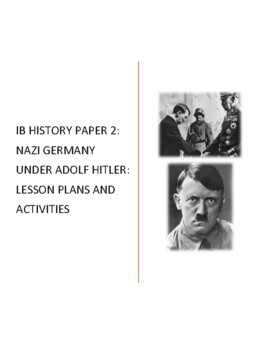IB History Paper 2: Authoritarian States: Hitler's Germany - Lessons/Activities
- PDF
Also included in
- This Bundle Set includes all of the lessons related to Nazi Germany, Fascist Italy, the People's Republic of China, and the Soviet Union. These lessons are aligned with the IBO's 2017 and 2020 History Guide. These lessons include the following themes: Emergence of an Authoritarian/One-Party State RuPrice $210.60Original Price $234.00Save $23.40
Description
This bundle set of lessons is devoted to IB History Paper 2: Authoritarian States - Nazi Germany under Adolf Hitler. There are eight lessons within this bundle set. Each lesson has different activities that enable students to interpret different types of sources - primary and scholarly documents as well as paintings and posters. These lessons are aligned to the IB History Paper 2 standards from the IBO's 2017 and 2020 publication editions.
The following lessons focus on the various topics found on the Paper 2 Authoritarian States section within the IB History examination: Rise to Power; Ideology; Consolidation of Power; and Economic and Social Policies (Domestic Policies).
The lessons are:
1. The Political and Economic Problems within Weimar Germany and the emergence of Hitler and the Nazi Party, 1920-1933 Italy and the Road to War - Primary and Secondary Source Analysis Lesson & Activity.
2. The Evolution of Nazi Ideology from 1920 through 1939 - Primary Source Activity that includes excerpts from speeches and articles written during the Weimar and Nazi eras - Continuity/Change Comparison Activity
3. Nazi Propaganda & the German Populace 1930s Propaganda Analysis - a variety of posters produced within the 1930s where students need to analyze the underlying messages. Extension Activity: First-hand accounts of why certain groups joined the Nazi Party and/or favored the Nazis over other competing political groups (i.e., the Communists and the Catholic Centre).
4. As part of a larger subsection within this lesson on Nazi Propaganda, students will assess Triumph of the Will. Guideline questions are provided for students. A TEACHER ANSWER KEY IS ALSO PROVIDED.
5. Hitler's Consolidation of Power/Domestic Policies - Students, working in groups, will examine the relationship between the Nazi regime and the various groups within Nazi Germany (youth groups, women, Catholic Church, and the army) and determine whether or not the policies were effective. Primary and Secondary Source Activity.
6. Resistance within Nazi Germany - Primary and Secondary Source Activity - Students will examine how effective the Nazi regime was in combating resistance within Nazi Germany from the youth (Edelweiss Pirates and the White Rose Movement); the Catholic Church (Confessing Church); and the army (Colonel Stauffenberg and Operation Valkyrie)
7. The Holocaust - Hitler's Other War - The Nazi regime's policies related to Jews, 1933-1945 - this is a primary source activity that begins with the analysis of the April boycott in 1933 through the Final Solution (1941-1945) and testimonies provided by those convicted for war crimes in the Nuremberg Trials (1945-1948).
8. The Evolution of Hitler's Foreign Policy - Continuity and Change Primary Source and Secondary Activity that enables students to examine Hitler's foreign policies throughout the 1930s from Hitler's private letter to Colonel Walther von Reichenau in 1932 on his desire to revolutionize Germany's military forces to the Nazi-Soviet Pact in late August 1939. This lesson includes a timeline activity to gauge the students' overall understanding of the evolution of Germany's foreign policy. A TEACHER ANSWER KEY IS ALSO PROVIDED.






